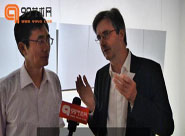Futurist Architect -
Yuan Shun’ Imagined Landscapes
1. Photography as integrative medium
Oddly enough, Yuan Shun’s works of art and photography originate from fabrications. They are models that the artist creates only to destroy them again once they have been fixed into photographic moments in a production of simulated wafts of mist, as the space of the model as well as the time of the moment. Through the steered view of the photographic process they are to be made associate-able as a different space and time.
What may also appear odd is the medial distancing from the installation of the model, created via the act of the photo shot. And that, considering we are used to dealing with models of architecture as catalysts of phantasmagoric worlds. This, for instance, is the case with Russian revolutionary art between the first and second World Wars, primarily W.E. Tatlin’s Model of the Monument for the III. International in 1920. It is also true for the many visionary designs of deconstructivist fantasies, such as those of the Viennese COOP Himmelblau, before designs by Frank O. Gehry, Daniel Libeskind und Zadid Habib ventured out on the road to their triumphal realization.
Admittedly, the architectural elements coming together in Yang Shun’s installations do not possess the same attributes, so that his work is not about ruling the chaos created by the merging of these forces. Instead, these elements differ in essence. Those representing mountainscapes merge with those that represent interventions by civilization. They are residual urbanities that are embedded within a sunken, deserted cultural expanse, and at the same time can be read as re-shuffling (themselves) anew. Perhaps we can understand Yuan Shun’s photographs better if we consider them so-called “stills“ as in contemporary science fiction movies such as Mad max, that is to say if we see them as an eclectic merging of Gothic and future-oriented stylistic shapes and technologies.
In our appreciation of Yuan Shun’s art we consequently oscillate between architectural models, sculptural, frozen stage settings of a theatre production on one hand, and sci-fi impressions on the other. But as it is the artist’s intent to likewise catch a performance – namely that of the “mist-ification” – it is only via the medium of photography that such simultaneity can be created. If the decomposition into a movement would happen via another artistic medium, such as film or theatre performance, then the complexity of the assertion would be overly standardized. In fact, it would lead into a purely narrative structure and would thus merely become the narrative of the invention of a geographic space. Photography allows for more doubts regarding scale and dimension of these imagined landscapes than does a documenting video recording. Are these landscapes small as models, or are they in fact as big as the earth, or even as big as a planet?
Through photography, Yuan Shun is able to state more adequately what I consider to be essential to him, namely the dignity of a spiritual landscape – a landscape of the soul – which does not wish to rely on the anthropological presence of an immanently sober observer, nor exist vis-à-vis the phenomenon of a superior nature (as is the case in Caspar David Friedrichs’ romantically conjuring celebrations of nature). Yet Yuan Shun knows how to merge the occurring, existing natural and human desert into a spirituality, which he or art as such has summoned. Here, Yuan Shun is programmatically close to Francois Lyotard’s concept of the sublime as the aesthetic of the inconceivable.
This connecting spiritual element, which acts as carrier of a mental state still attainable, we find in the wafts of mist - floating, quasi-immaterial, and placed on the solid body of the figuration - that is, in the performance of the structure which the artist himself created. As a small creator (vis-à-vis The Creator of the world or of Nature, of the itself ever re-arranging and re-stating Nature.)
-2-
and by falling back upon their history, he constructs in these landscapes, which are as good as completely devoid of all hospitability, a kind of aesthetic dignity. Here, history means the presence of the mythical, and how this presence imbues culture and religion, as for instance in the case of Chinese history. (But of course, this phenomenon is not limited to Chinese history.) The steep, haughty mountain crests, which we can also find in Albrecht Altendorfer’s “Alexanderschlacht“ from 1529 (Munich, Museum Alte Pinakothek), constitute an exemplary bridge of congeniality in artistic expression, which spans time and nations.
Time and again there have been courageous attempts in art history to re-create myths. Interestingly enough, most of these attempts have been musical synthesis of the arts, as for instance Richard Wagner’s operas in the 19th century, or the opera “Victory over the sun“, which was composed by Malewitsch, Krutschjonych and Maitjuschin in 1913. Music was the medium, because the music of the Wagnerian billows and mists of sound, or the cubistic-futuristic sound texture (Klangmuster) could constitute flexible (because organic) standardizations of dramatic dichotomies. The wafts of mist in Yuan Shun’s photographs function similarly. Only photography provides the adequate medium for the registration of such kind of “notation.”
2. Sign-Placement (Zeichensetzung) of landscape and culture as archaic-futuristic dodge: an excursion
“Homo sapiens” has indeed left his mark albeit he only recently (geologically calculated) made his first appearance on this planet. Most of his species has marred the face of the earth, of the „Terra Mater,” and have left cloddish scars upon her. There are hardly any marks to be found that are in harmony with their surrounding natural environment. And if they are, then they always appear in combination with a habitat: archaic cities in the sand, medieval city fortresses, and architectural ensembles of the Renaissance. We have perfectly learned to decode the language that these marks speak. And, what’s more, we even “read” them over and over again. Their language is an integral part of our understanding of culture and of our aesthetic “augmentation of life” (Lebenssteigerung).
It is different, though, with those marks, which cannot be attributed to the secured sphere of our urban “life-feeling” (Lebensgefühl) as citizens. That is to say, when human buildings have been scattered inside a landscape, then this kind of exposure becomes thematic. And if mythical practices have been applied in the composition of a landscape, then that was done as for instance in the case of the landscape signs (Landschaftszeichen) in Nazca, Peru, which arrange their gigantic, geometrical marks in a way that only the gods looking at this scenario from above would have been able to visualize this lay-out to its full extent. Similar ideas of projection from a bird’s eye view can be found in figuratively outlined prehistoric landscape signs in England. However religious, astronomical and ritual the purpose of their creation may have been, their designers have created the earliest works of art by establishing their constructions as an own scale in opposition to nature. Despite all their mightiness, exposed structures such as the pyramids of Egypt, the Sardinian Nuraghe, and the Great Wall of China subjugated themselves to Nature, and thus turned to landmarks themselves. With the construction of the Tower of Babel, then, the measure of compatibility with Nature was obviously transgressed. In contrast to the hypertrophic constructions of modern times, what collapsed was the actual construction, and not Nature.
Consenting with the planet, or at the very least acknowledging and respecting it, was replaced by more and more brutal interventions. Dams, straightening of rivers, sealing up of ground, ski resorts, slash-and-burn have basically not even attempted to position themselves in relationship to their surrounding

